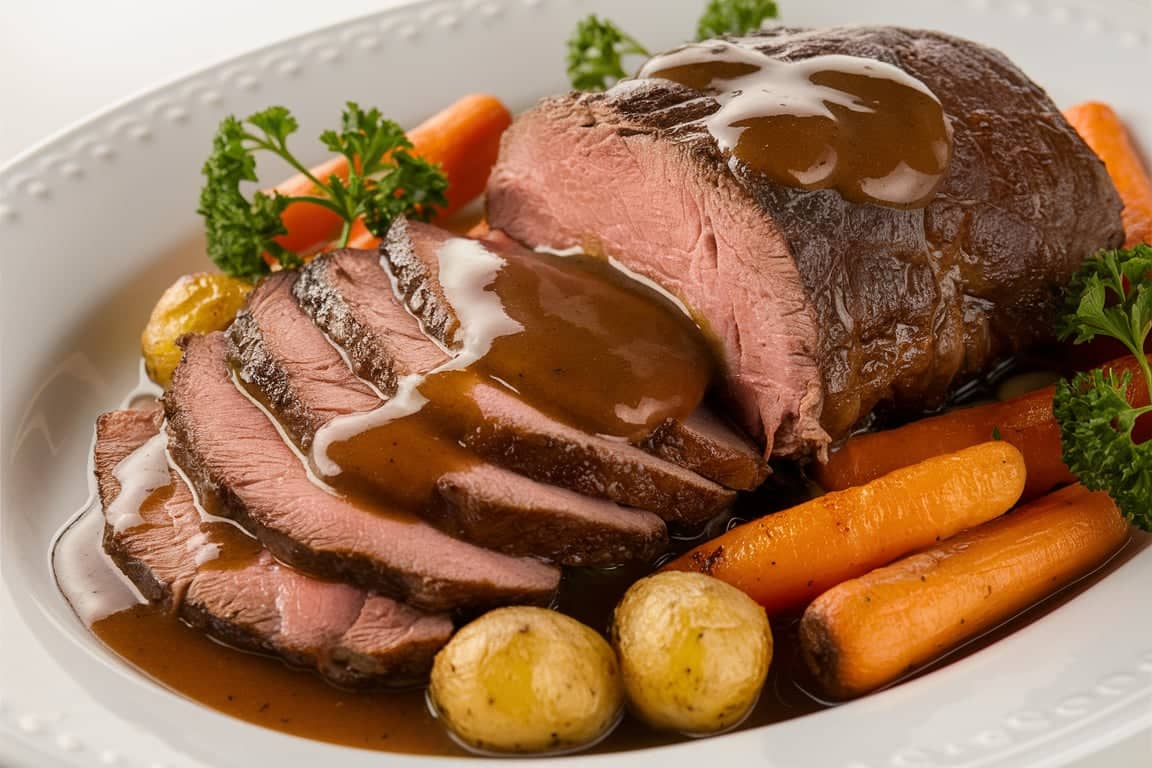When it comes to classic comfort food, few dishes compare to a beautifully cooked bottom round roast recipe. Whether you’re planning a cozy family dinner or a fancy weekend meal, this cut of beef can transform your table into a feast. But let’s be honest—it’s not always easy to nail this recipe. Don’t worry, though! By the time you finish this guide, you’ll know everything about preparing a juicy, tender, and flavorful bottom round roast.
Table of contents
What is a Bottom Round Roast?
Understanding the Cut of Meat
So, what exactly is a bottom round roast Recipe? Think of it as one of the underdogs of the beef world. It’s a lean cut taken from the rear leg of the cow. Unlike pricier cuts like ribeye or tenderloin, it doesn’t have much fat marbling, which makes it less tender naturally. But here’s the good news: with the right techniques, you can turn this affordable cut into a show-stopping dish.
Why Choose Bottom Round Roast Recipe for Your Meals?
Why pick this cut over others? Simple—it’s budget-friendly and versatile. It’s ideal for feeding a crowd without breaking the bank. Plus, it absorbs marinades like a sponge, making it perfect for experimenting with flavors. Whether roasted, slow-cooked, or even air-fried, this cut shines when treated right.
“The bottom round roast is proof that with a little care, even the humblest cuts of beef can become the star of your table.”
Preparing for the Perfect Bottom Round Roast
Essential Ingredients for a Bottom Round Roast Recipe
Before you even think about cooking, gather your ingredients. You don’t need anything fancy—just some kitchen staples:
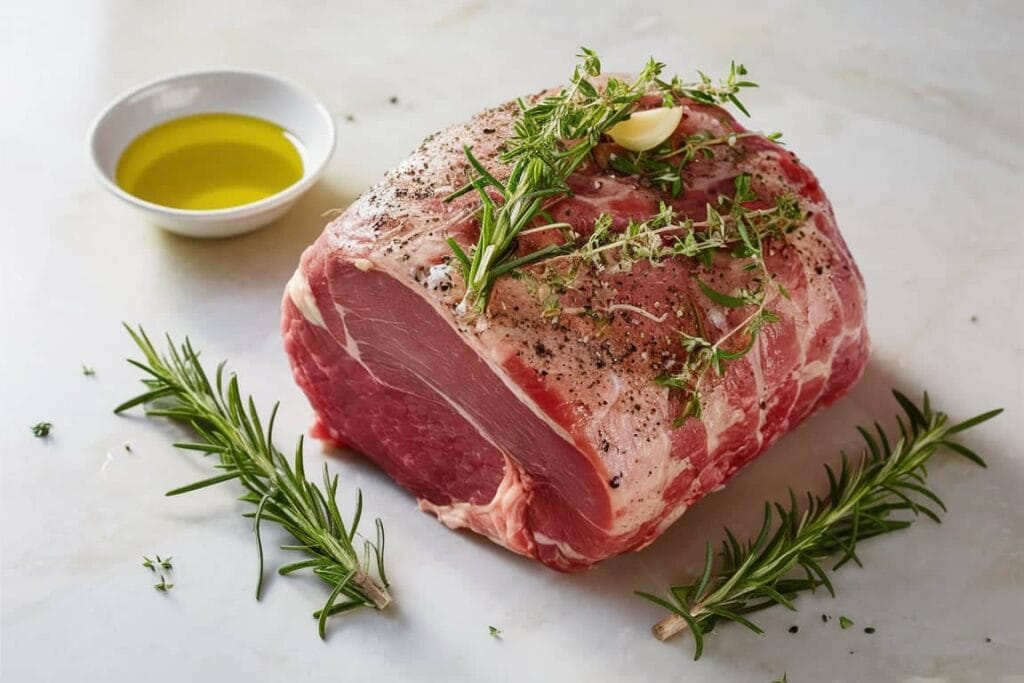
- Bottom Round Roast Recipe: Aim for a 3-4 lb roast.
- Seasonings: Salt, pepper, garlic powder, and onion powder.
- Herbs: Rosemary and thyme work wonders.
- Cooking Fat: Olive oil or butter.
- Veggies (Optional): Carrots, onions, and potatoes for a complete meal.
- Broth or Wine: Adds moisture and depth to your roast.
Necessary Tools for Roasting Success
Tools matter! Here’s what you’ll need for a hassle-free cooking experience:
- Meat Thermometer: For perfect doneness.
- Roasting Pan: Ensures even cooking.
- Aluminum Foil: Keeps moisture locked in.
- Sharp Knife: For slicing cleanly.
- Cutting Board: Protects your counters and helps with clean-up.
How to Select the Best Bottom Round Roast at the Market
When shopping, look for:
- Bright Red Color: Freshness is key.
- Minimal Fat Cap: Since it’s lean, you don’t want too much fat.
- Firm Texture: A good roast should feel firm when you press it.
Feeling lost in the meat aisle? Ask your butcher for help! They’ll guide you to the freshest cut available.
Common Mistakes and How to Avoid Them
Cooking a bottom round roast Recipe can go wrong if you’re not careful. Here are a few pitfalls to dodge:
- Skipping the Marinade: This cut needs moisture, so always marinate for at least a few hours.
- Overcooking: Use a thermometer to avoid turning it into a brick.
- Slicing Too Soon: Letting it rest is essential to keep juices intact.
“Cooking is like painting. A good roast is your canvas, and seasoning is your palette.”
The Step-by-Step Bottom Round Roast Recipe
Now that you’re armed with the knowledge and tools, it’s time to roll up your sleeves and start cooking. This step-by-step guide will help you create a tender and flavorful bottom round roast that will leave everyone asking for seconds.
Preparing the Meat: Trimming and Seasoning
First things first—prepping your roast is like setting the stage for a great performance. Start with these steps:
- Trim the Roast: Use a sharp knife to remove any excess silver skin or tough connective tissue. Leave a thin layer of fat for flavor, but don’t overdo it.
- Season Generously: Combine salt, pepper, garlic powder, and onion powder in a small bowl. Rub this mixture all over the roast, ensuring every inch is coated. If you’re using herbs like rosemary or thyme, press them gently onto the surface.
“Seasoning is the soul of a good roast—it’s where the magic begins.”
- Optional Marinade: For extra moisture and flavor, marinate the roast in a mixture of olive oil, red wine, minced garlic, and fresh herbs. Let it sit in the fridge for 4-8 hours. Trust me, this step is worth it!
Best Marinades and Rubs for Maximum Flavor
Not sure how to marinate? Here’s a simple recipe:
- 1/4 cup olive oil
- 1/4 cup red wine (or beef broth)
- 3 cloves garlic, minced
- 2 tsp soy sauce
- 1 tsp dried rosemary
- 1 tsp thyme
Mix everything in a zip-top bag, add the roast, and let it soak. The acidity of the wine tenderizes the meat, while the herbs infuse it with incredible flavor.
Cooking Methods: Oven Roasting vs. Slow Cooking
Now comes the fun part—choosing your cooking method. Each approach has its perks, so pick one that suits your schedule and taste.
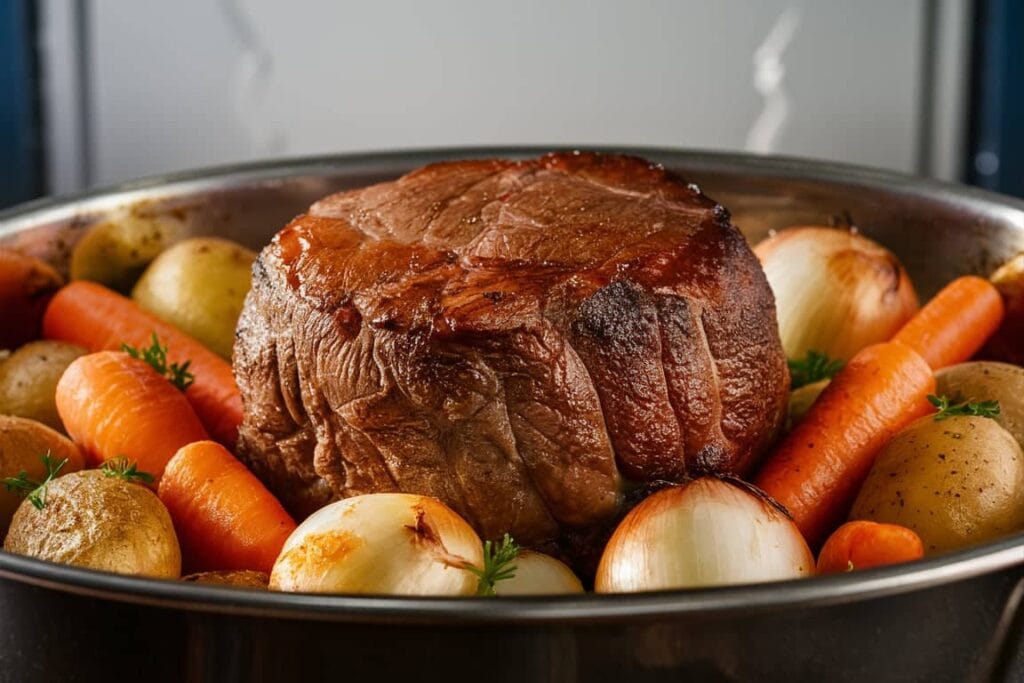
Oven Roasting
- Preheat: Set your oven to 450°F (230°C).
- Sear the Roast: Heat a skillet with a bit of oil and sear the roast on all sides. This locks in the juices and gives a beautiful crust.
- Prepare the Pan: Place your roast on a roasting rack in a pan. Surround it with carrots, onions, and potatoes for a full meal.
- Roast and Reduce Heat: Place the pan in the oven and roast at 450°F for 15 minutes. Then, lower the temperature to 325°F (165°C) and continue cooking until the internal temperature reaches 135°F (medium-rare) or 145°F (medium).
Slow Cooking
- Set Up the Cooker: Add a layer of chopped vegetables (like onions and carrots) to the bottom of your slow cooker.
- Place the Roast: Add the seasoned roast on top of the veggies.
- Add Liquid: Pour in about 1 cup of beef broth or wine to keep things moist.
- Cook Low and Slow: Set the slow cooker to low and cook for 6-8 hours, or until the meat is fork-tender.
Resting and Carving the Roast
Once your roast is cooked, patience is key:
- Rest the Meat: Remove the roast from the oven or slow cooker and tent it with aluminum foil. Let it rest for 15-20 minutes. This step ensures the juices redistribute, keeping the meat juicy.
- Carve Like a Pro: Use a sharp knife and slice against the grain. Thin slices work best for this cut, as they maximize tenderness.
“Slicing against the grain is the golden rule—it’s the difference between melt-in-your-mouth and chewing forever!”
Pro Tips for Success
- Check Temperature Early: Use a meat thermometer to avoid overcooking. The roast can go from perfect to dry in minutes.
- Baste for Extra Flavor: Spoon pan juices over the roast during cooking to keep it moist and flavorful.
- Save the Drippings: Those juices make an amazing gravy—don’t let them go to waste!
Common Problems with Bottom Round Roast and How to Fix Them
Cooking a bottom round roast can feel like a gamble. One moment you’re confident, and the next, you’re staring at a dry, tough piece of meat. Sound familiar? Let’s tackle the most common problems and how to solve them so every roast turns out perfect.
Why Does My Roast Turn Out Tough?
This is one of the most frequent complaints. Bottom round roast is lean, so it lacks the natural fat that keeps other cuts tender. But don’t worry—there are solutions:
- Problem: Overcooking. When you overcook a bottom round roast, the muscle fibers tighten, making the meat chewy.
- Solution: Use a meat thermometer. For medium-rare, aim for an internal temperature of 135°F. Pull it from the oven a few degrees early, as the temperature rises while resting.
- Problem: Cooking it too fast.
- Solution: Low and slow is your best friend. Whether in the oven or slow cooker, give the roast time to break down its tough fibers.
“Patience in cooking isn’t just a virtue—it’s the secret ingredient to tender meat.”
How to Avoid Dry Bottom Round Roast
A dry roast can ruin even the best intentions. Here’s why it happens and how to fix it:
- Problem: Lack of moisture during cooking.
- Solution: Add liquid. Use beef broth, wine, or even water in your roasting pan or slow cooker. This creates steam, keeping the roast juicy.
- Problem: Not covering the roast.
- Solution: Tent it with aluminum foil during the cooking process or use a lid if you’re slow cooking. This traps the moisture inside.
- Problem: Skipping the resting period.
- Solution: Always let the roast rest for 15-20 minutes after cooking. This locks in the juices, so they don’t spill out when you slice it.
Salvaging an Overcooked Roast
Okay, so you overcooked it—don’t panic! You can still save the day with a little creativity.
- Shred It: If the roast is too tough, shred it and toss it in barbecue sauce for a pulled beef dish.
- Slice Thinly: Thin slices are easier to chew, even if the roast is overdone.
- Make a Sauce: A rich gravy or sauce can bring back some moisture and flavor. Use the drippings from the pan as your base.
“Cooking isn’t about perfection—it’s about adapting and making the best of what you’ve got.”
Tips for Consistent Success
Let’s be honest—avoiding problems entirely is the dream. Here are some golden tips to make that happen:
- Start with Room Temperature Meat: Taking the chill off your roast helps it cook evenly.
- Don’t Skip Searing: Browning the meat locks in flavor and creates a crust that’s hard to resist.
- Rotate the Pan: In the oven, rotate the roasting pan halfway through cooking to ensure even heat distribution.
- Invest in a Quality Thermometer: Seriously, it’s a game-changer. No more guessing if your roast is done.
A Quick Troubleshooting Chart
| Problem | Solution |
|---|---|
| Tough Roast | Slow cook, slice thin, rest well |
| Dry Roast | Add liquid, baste, or make a gravy |
| Overcooked Roast | Shred, slice thin, or repurpose in dishes |
| Bland Flavor | Use marinades, rubs, and proper seasoning |
Pro Tip: Make It Foolproof
If you’re still nervous, try the slow cooker method. It’s almost impossible to mess up, and it guarantees tender, flavorful results every time.
Side Dishes to Pair with Bottom Round Roast
A good roast is only as strong as its supporting cast. Pairing your bottom round roast with the right side dishes elevates it from great to unforgettable. Here are some classic and creative ideas.
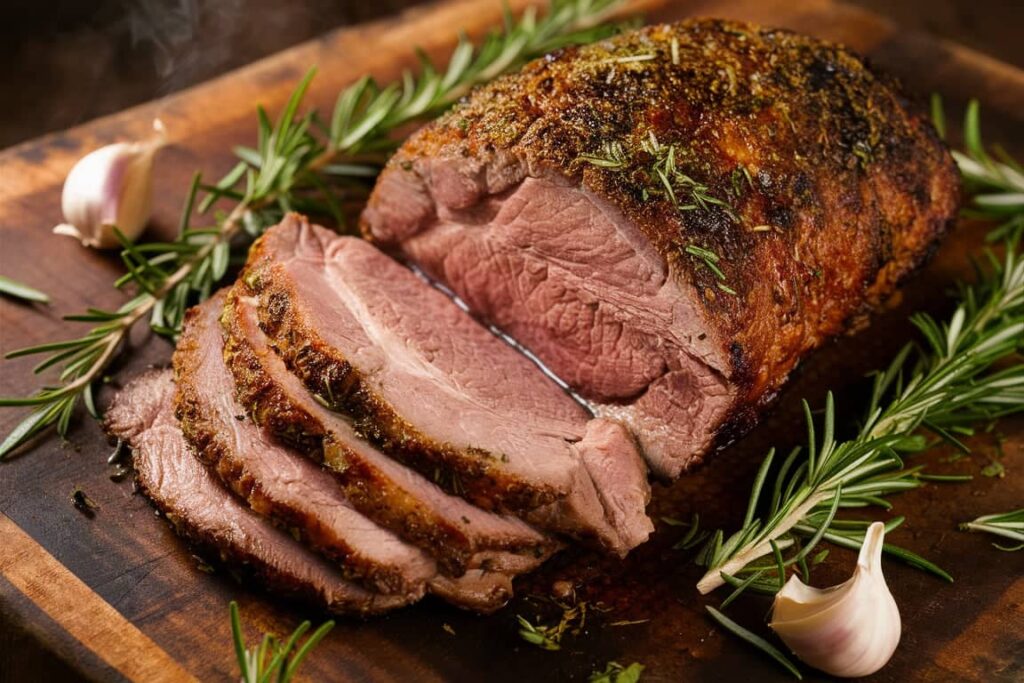
Classic Pairings: Mashed Potatoes and Gravy
What’s a roast without mashed potatoes? They’re the yin to your roast’s yang.
- Creamy Mashed Potatoes: Whip them with butter, cream, and a pinch of garlic powder for that melt-in-your-mouth texture.
- Gravy: Don’t let the pan drippings go to waste. Whisk them into a rich gravy with a bit of flour and beef broth.
“Mashed potatoes and gravy are the culinary equivalent of a warm hug—they just belong together.”
Unique Options: Roasted Vegetables and Quinoa
If you want to switch things up, try:
- Roasted Veggies: Toss carrots, brussels sprouts, and parsnips with olive oil and herbs, then roast them alongside your meat.
- Herbed Quinoa: This nutty, protein-packed grain adds a light and healthy balance to the meal.
Light and Fresh Sides
Balance the richness of the roast with these fresh ideas:
- Simple Green Salad: Mixed greens with a tangy vinaigrette cut through the roast’s richness.
- Steamed Asparagus: A squeeze of lemon brings a bright, fresh note.
Variations of Bottom Round Roast Recipe
One of the best things about this cut is its versatility. Here are three delicious ways to customize your roast.
Classic Herb-Crusted Bottom Round Roast
- Ingredients: Garlic, rosemary, thyme, olive oil, and Dijon mustard.
- Method: Rub the roast with the mixture before cooking. The herbs create a crust that locks in flavor.
Garlic and Butter Bottom Round Roast
- Ingredients: Minced garlic, butter, and parsley.
- Method: Baste the roast with garlic butter every 20 minutes during cooking. The result? A juicy, flavorful roast with buttery richness.
Asian-Inspired Bottom Round Roast with Soy Sauce
- Ingredients: Soy sauce, ginger, honey, and sesame oil.
- Method: Marinate the roast in this mixture for at least 4 hours. Serve with steamed rice and sautéed bok choy for a complete meal.
“Think of variations as your roast’s wardrobe—it’s the same great cut, but with endless outfits.”
Nutritional Value of Bottom Round Roast
Let’s talk numbers. Is bottom round roast a healthy choice? You bet!
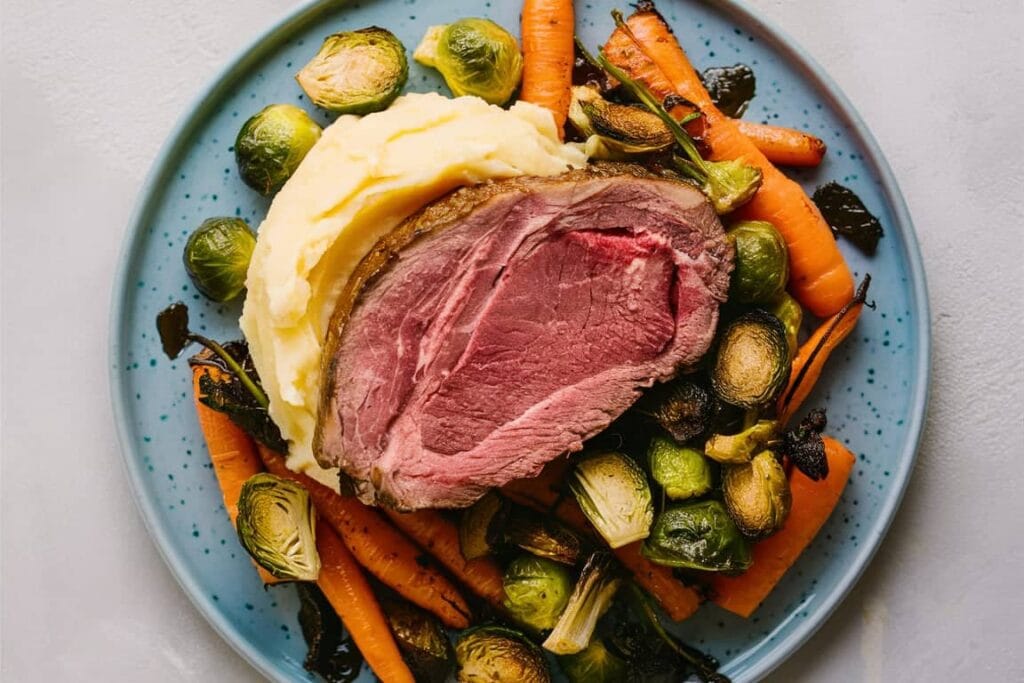
- Calories: About 200 calories per 3-ounce serving.
- Protein: A whopping 25 grams per serving, making it perfect for muscle building.
- Low in Fat: With only about 5 grams of fat, it’s a lean option compared to other cuts.
Health Benefits
- Iron Boost: Packed with iron, it helps maintain energy levels.
- Rich in B Vitamins: Supports metabolism and brain health.
Frequently Asked Questions About Bottom Round Roast
Got questions? We’ve got answers.
How Long Should I Cook Bottom Round Roast?
It depends on the method:
- Oven: 20 minutes per pound at 325°F for medium-rare.
- Slow Cooker: 6-8 hours on low.
What’s the Best Way to Slice Bottom Round Roast?
Always slice against the grain. This shortens the muscle fibers, making the meat tender and easy to chew.
Can I Freeze Bottom Round Roast?
Absolutely! Slice it, wrap it tightly in foil, and store it in a freezer bag. It’ll stay good for up to 3 months.
Final Thoughts: Mastering the Bottom Round Roast Recipe
Mastering the bottom round roast isn’t just about following a recipe—it’s about understanding the cut, embracing the process, and adding your own flair. Whether you’re cooking for family or impressing guests, this affordable cut can steal the show with the right care.
So, what are you waiting for? Grab your roast, fire up the oven or slow cooker, and make your kitchen smell like pure comfort. And remember, every roast tells a story—make yours unforgettable.
“Cooking is an art, and every roast is your masterpiece. Don’t just make dinner—create something worth savoring.”

